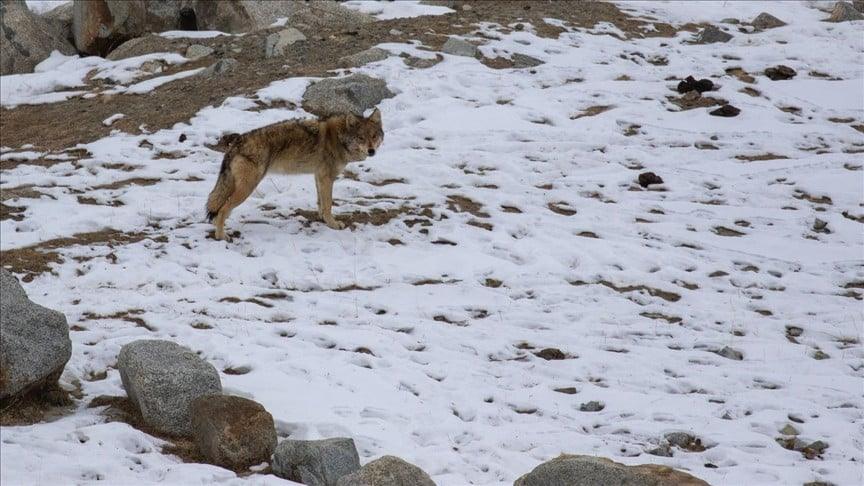As Pakistan has witnessed a dramatic decline in his wolf populations in the past few decades, experts warn that the already threatened species without immediate conservation measures may face local extinction in the near future.
The population of both the Indian wolf and the Tibetan wolf in Pakistan decreases at an alarming speed where only a few hundred individuals are left in the country.
Human-induced factors, such as habitat destruction, murder of retaliatory killings and diminishing swap populations, are the primary causes of this fall, according to Rab Nawaz, a senior official in WWF-Pakistan.
“Pakistan has a rich diversity of wildlife, but many of its species, including wolves, are threatened and face the threat of local extinction,” Nawaz told Anadolu.
In recent years, he added, human-induced pressure has intensified the decrease in wolf population in Pakistan, while significant gaps in ecological knowledge and population distribution further prevent conservation efforts.
“Especially the Indian wolf is recognized as threatened in Pakistan, but central knowledge holes regarding its population status and distribution make conservation efforts difficult,” he said.
Recent genetic studies have revealed that Indian wolves are among the most evolutionarily different wolf populations found only in India and Pakistan.
Saeed-Ul Islam, an expert in wildlife, agrees with Nawaz and emphasizes that the Indian wolf population is falling at a much faster speed than the Tibetan wolf and puts its survival at serious risk.
The Tibetan wolf – also known as the Chinese wolf, Mongolian wolf, Korean wolf, Steppes Wolf or Woolly Wolf – has a relatively stable population because of the nature of its habitats and less human intervention, he explained.
The Tibetan wolf, believed to be a subspecies of the gray wolf, is found in parts of central China, southwestern Russia, Manchuria, Tibet and the Himalayas in India, Nepal and Bhutan.
The species is already classified as “vulnerable” because of its low population and is included in the red list of International Union for Conservation of Nature (IUCN), a global body that focuses on nature protection.
Pressing need for conservation measures
Experts quote retaliation killing, loss of habitats and growing human population as the primary factors behind the decline of the Indian wolf found in the plains of southern Sindh, southwestern Balochistan and the northeast Punjab provinces.
“Conflict with humans-Wildlife is the biggest factor, followed by population growth and destruction of habitat, which threatens the Indian wolf with local extinction,” Islam said.
In addition, he pointed out that the prey for the Indian wolf has drastically decreased due to rapid deforestation and a rising human footprint in recent decades.
In contrast, the Tibetan wolf is in the mountains of the northern Gilgit-Baltistan, the northwestern Khyber Pakhtunkhwa Province and the disputed Kashmir region, where it has relatively stable habitats, better prey accessibility and lower human interaction.
“But still their population is vulnerable,” he warned.
According to Islam, Indian wolf population in Pakistan is probably no more than a few hundred, although no official population assessment has been made.
“If serious conservation efforts are not immediately implemented, we may lose the Indian wolf forever in the coming years,” he warned.
He emphasized the urgent need for population assessments, identification of population clusters, establishment of shrines and restoration of habitat to preserve the remaining Indian wolf population.
“All of this cannot happen without a proper population assessment and identify central habitat areas,” he said, recognizing that the issue has not received the necessary attention from either the government or the wildlife organizations.
Mohammad Kabir, who heads the Wildlife Ecology Lab at the University of Haripur in Khyber Pakhtunkhwa, emphasized that Wolves kill a large number of livestock, which is an important factor in the conflict with humans.
“To mitigate conflicts, conservation management programs should include livestock insurance, vaccination and attention campaigns,” Kabir told Anadolu.
Such measures, he explained, would help reduce livestock mortality due to illness and prevent retaliatory killings of wolves by farmers suffering from financial losses.
Wolves role in ecosystem balance
Pakistan has over 23,000 square kilometers (8,880 square miles) appropriate wolf habitat, spread over remote and inaccessible areas associated with natural corridors, according to Kabir.
Sharifuddin Baloch, the Main Conservator of Balochistan’s Wildlife Department, said the government has declared several national parks and game reserves as protected areas of the Indian wolf in an attempt to preserve its population.
“The Indian wolf has already been designated as a protected species in Balochistan and the rest of Pakistan. However, conservation efforts have not produced the desired results due to continued retaliatory killings, climate change and the wolf’s own predator behavior, ”Baloch explained.
“Conservation efforts have produced satisfactory results in protected areas, but they have been largely ineffective in other regions because of the ongoing conflict between people and lives,” he added.
One of the primary causes of this conflict, he noted, is the way Wolves Hunt’s house animal.
“They attack in packages and kill several animals at a time, unlike other predators that are only targeted at a single or a few animals for food. This makes them the biggest enemy of farmers and shepherds, ”Baloch said.
Cattle are a primary source of livelihood in Pakistan in rural areas, especially in Balochistan, where wolves retaliatory are common.
“The huge patrol areas with wolves also make it difficult to protect them from human meetings and other dangers,” he added.
Kabir, the wildlife scientist, emphasized Wolves’ critical role in the regulation of prey populations and maintaining ecosystem balance.
“Wolves are among the least studied predators in Pakistan and have been largely ignored in research and conservation programs. As a top predator in their habitats, they regulate the population of other prey species, ”he said.
“Their absence would lead to an uncontrolled increase in prey populations causing overgrazing, degradation of habitat, resource competition and ultimately the collapse of prey populations,” he warned.
A decrease in wolf populations, he added, could also lead to an increase in smaller predators, which further disturbed the ecological balance.
“As a predators, wolves help control the spread of the disease by targeting sick, old and weak prey. Without them, diseases could spread faster among prey populations, ”he noted.



